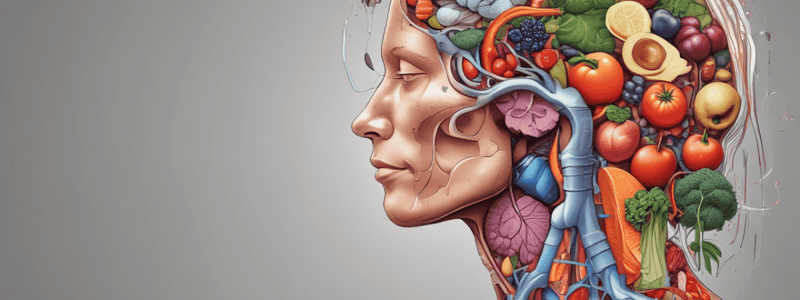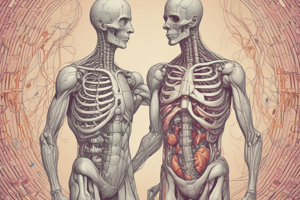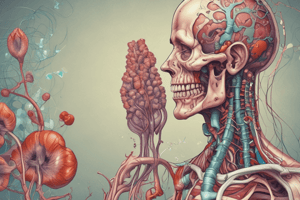Podcast
Questions and Answers
What is the normal heart rate of an animal?
What is the normal heart rate of an animal?
- 200-400 beats per minute
- 150-300 beats per minute (correct)
- 50-100 beats per minute
- 100-150 beats per minute
What is the primary function of protein in an animal's diet?
What is the primary function of protein in an animal's diet?
- To insulate the body
- To form cholesterol and steroids
- To provide essential amino acids for growth and repair (correct)
- To provide energy for movement
What is the main difference between carbohydrates and fats in terms of energy provision?
What is the main difference between carbohydrates and fats in terms of energy provision?
- Carbohydrates and fats provide the same amount of energy
- Carbohydrates provide more energy than fats
- Fats provide more energy than carbohydrates (correct)
- Fats are not a source of energy
What is the primary function of minerals in an animal's body?
What is the primary function of minerals in an animal's body?
What is the normal temperature range for an animal?
What is the normal temperature range for an animal?
What is the primary function of lipids in an animal's diet?
What is the primary function of lipids in an animal's diet?
What is the main function of the cecum in certain animals?
What is the main function of the cecum in certain animals?
What is the primary function of water in the body?
What is the primary function of water in the body?
What type of digestive system is characterized by a single compartment stomach?
What type of digestive system is characterized by a single compartment stomach?
Which of the following is a sign of a sick rabbit?
Which of the following is a sign of a sick rabbit?
What is the main difference between ruminant and non-ruminant digestive systems?
What is the main difference between ruminant and non-ruminant digestive systems?
What is the primary function of the digestive system?
What is the primary function of the digestive system?
What is the purpose of a breeding record in rabbitry?
What is the purpose of a breeding record in rabbitry?
What is the age range for a rabbit to be classified as a 'fryer' or 'young rabbit'?
What is the age range for a rabbit to be classified as a 'fryer' or 'young rabbit'?
What is the primary characteristic of the flesh of a 'roaster' or 'mature rabbit'?
What is the primary characteristic of the flesh of a 'roaster' or 'mature rabbit'?
Why is it important to keep good records in rabbit breeding?
Why is it important to keep good records in rabbit breeding?
What is the primary purpose of raising Angora rabbits?
What is the primary purpose of raising Angora rabbits?
What is the term for a rabbit raised for its fur to be tanned and made into novelty products?
What is the term for a rabbit raised for its fur to be tanned and made into novelty products?
What is the primary purpose of a show record in rabbitry?
What is the primary purpose of a show record in rabbitry?
What is the term for a rabbit raised for human consumption?
What is the term for a rabbit raised for human consumption?
The tattoo should be placed below the main visible vein in the rabbit's left ear.
The tattoo should be placed below the main visible vein in the rabbit's left ear.
Rabbits with very hot ears may not bleed excessively.
Rabbits with very hot ears may not bleed excessively.
The tattoo digits should be applied from top to bottom in the rabbit's ear.
The tattoo digits should be applied from top to bottom in the rabbit's ear.
The side of the tattoo pliers with the digits should be outside the ear.
The side of the tattoo pliers with the digits should be outside the ear.
The ear should be folded when applying the tattoo.
The ear should be folded when applying the tattoo.
The tattoo pliers should be squeezed together for 5 seconds to ensure needles penetrate through the inner skin of the rabbit's left ear.
The tattoo pliers should be squeezed together for 5 seconds to ensure needles penetrate through the inner skin of the rabbit's left ear.
Tattooing a rabbit is a method of identification that can be used on both ears.
Tattooing a rabbit is a method of identification that can be used on both ears.
The giblets of a rabbit include the liver, heart, and kidneys.
The giblets of a rabbit include the liver, heart, and kidneys.
A clean and dry ear is not necessary before applying the tattoo.
A clean and dry ear is not necessary before applying the tattoo.
The tattoo digits should be selected at random for each rabbit.
The tattoo digits should be selected at random for each rabbit.
What type of record includes information about each rabbit, such as sire, dam, and color?
What type of record includes information about each rabbit, such as sire, dam, and color?
What is the primary purpose of raising Angora rabbits?
What is the primary purpose of raising Angora rabbits?
What is the purpose of attending shows with your rabbits?
What is the purpose of attending shows with your rabbits?
What is important to consider when raising Angora rabbits for wool production?
What is important to consider when raising Angora rabbits for wool production?
What is a common use of rabbits raised for fur?
What is a common use of rabbits raised for fur?
What is important to do before tattooing a rabbit?
What is important to do before tattooing a rabbit?
Where should the tattoo be placed in the rabbit's left ear?
Where should the tattoo be placed in the rabbit's left ear?
What should be done if the rabbit's ears are dirty?
What should be done if the rabbit's ears are dirty?
How should the tattoo pliers be positioned in the ear?
How should the tattoo pliers be positioned in the ear?
What should be done after the tattoo pliers are properly positioned?
What should be done after the tattoo pliers are properly positioned?
What is common in young rabbits when tattooing?
What is common in young rabbits when tattooing?
What should be done with the ink after applying the tattoo?
What should be done with the ink after applying the tattoo?
What should be applied over the tattoo after ink application?
What should be applied over the tattoo after ink application?
Why is it important to keep the ear straight when applying the tattoo?
Why is it important to keep the ear straight when applying the tattoo?
What is the purpose of a pedigree record in rabbit breeding?
What is the purpose of a pedigree record in rabbit breeding?
What is unique about the digestive system of monogastrics like horses, rabbits, and guinea pigs?
What is unique about the digestive system of monogastrics like horses, rabbits, and guinea pigs?
What is the term for a rabbit raised for its fur to be tanned and made into novelty products?
What is the term for a rabbit raised for its fur to be tanned and made into novelty products?
What is the primary purpose of raising Angora rabbits?
What is the primary purpose of raising Angora rabbits?
What is the primary difference between a ruminant and non-ruminant digestive system?
What is the primary difference between a ruminant and non-ruminant digestive system?
What should be included in a three-generation pedigree record?
What should be included in a three-generation pedigree record?
Flashcards are hidden until you start studying
Study Notes
Health
- Normal body temperature: 100-104 degrees Fahrenheit
- Normal heart rate: 150-300 beats per minute
- Normal respiratory rate: 30-60 breaths per minute
Nutrition
- Six basic nutrients: protein, carbohydrates, lipids, minerals, vitamins, and water
- Protein:
- Provides essential amino acids
- Essential for growth and repair
- Forms muscles, internal organs, skin, hair, wool, feathers, hoofs, and horns
- Contains carbon, hydrogen, oxygen, and nitrogen
- Carbohydrates:
- Provides energy for movement and body functions
- Largest part of an animal's feed supply
- Includes sugars, starch, and cellulose
- Composed of carbon, oxygen, and hydrogen
- Fats:
- Concentrated source of energy
- Form cholesterol, steroids, and other body compounds
- Found in every cell in the body
- Affects skin and hair condition when absent
- Composed of carbon, oxygen, and hydrogen
- Minerals:
- Needed in nearly all parts of the body
- Found primarily in bones and teeth
- Affect heartbeat and nerve transmission
- Divided into macro and micro minerals
- Vitamins:
- Required for health, development, and metabolic reactions
- Needed only in small amounts
- Divided into fat-soluble and water-soluble vitamins
- Water:
- Most important nutrient
- Accounts for 70% or more of body composition
- Functions: controls body temperature, enables shape, involved in nutrient transport and waste removal, and aids in digestion
Digestive Systems
- Types of digestive systems: ruminant or non-ruminant, single stomach
- Ruminant: bacterial breakdown in the rumen
- Non-ruminant: bacterial breakdown in the large intestine and cecum
- Monogastrics: unable to digest large quantities of fiber unless they have an enlarged cecum
Signs of a Sick Rabbit
- Decreased appetite
- Lethargy
- Hair loss
- Runny eyes
- Discharge from nose
- Diarrhea
- Sneezing
- Fever
- Changes in breathing
Rabbit Diseases and Symptoms
- Ear Canker (Ear mites): shaking head, flopping ears
Rabbit Breeding and Uses
- Breeding Stock: high-quality offspring, keeping records, attending shows
- Meat Production: raising rabbits for food
- Fur: raising rabbits for fur production
- Wool: raising rabbits for wool production, especially Angora breed
- Pets: raising rabbits for companionship
Meat Cuts
- Fryer or young rabbit: tender, fine-grained, and bright pearly pink, less than 12 weeks old
- Roaster or mature rabbit: firm, coarse-grained, and slightly darker in color, over 8 months old
Rabbit Health Issues
- Mastitis: symptoms include hot, reddened, and swollen mammary glands that may turn blue in color
- Myxomatosis: a virus spread by mosquitoes, fleas, or close contact between infected and susceptible rabbits, with symptoms including swelling and discharge from the eyes and nose
- Sore Hocks: bruised areas under the surface of the hocks that often become infected or abscessed
- Rabbit Viral Hemorrhagic Disease (RVHD): a virus spread by direct and indirect contact, often fatal with no warning signs, and symptoms including diarrhea with blood
- Ring Worm: loss of hair in circumscribed patches, often starting on the head and involving other body parts
- Wry Neck: the rabbit turns its head to one side and loses balance
- Weepy Eye: excessive discharge from the eye and matted fur under the eye, with the rabbit rubbing its eyes with its front feet
Reproduction
- Lactation average uninterrupted length: 42 days
- Lactation peaks at: 17-20 days
- Litters per doe per year: 2-10
- Litter size: 2-14 young
- Usual life span: 3-10 years
- Gestation period: 31 days
Rabbit Records
- Pedigree Record: lists the family tree of each rabbit, including sires, dams, grand sires, and dams, with information on color and senior weight
- Herd Record: includes information on every rabbit in the rabbitry, including sire, dam, sex, color, and date of birth
- Breeding Record: records each breeding, helping to decide which does are most productive and which bucks are best
- Show Record: includes dates and places of shows entered, with information on classes and awards received
Uses of Rabbits
- Breeding Stock: rabbits raised for high-quality offspring, with good records and show participation
- Meat Production: rabbits raised for meat
- Fur: rabbits raised for fur to be tanned and made into products
- Wool: rabbits raised for wool, with importance on cleanliness, durability, and ease of processing
- Pets: rabbits raised as companions, with potential sales to pet stores
Meat Cuts
- Fryer or young rabbit: rabbits weighing 1.5-3.5 pounds, less than 12 weeks old, with tender and fine-grained flesh
- Roaster or mature rabbit: mature rabbits over 4 pounds, over 8 months old, with firm and coarse-grained flesh
Tattooing a Rabbit
- Select tattoo digits for the first rabbit
- Place digits correctly in the pliers before tattooing
- Examine the location of the tattoo in the rabbit's left ear
- Clean and dry the ear before applying the tattoo
- Place the pliers in the correct position in the ear, with the digits inside the ear
- Squeeze the pliers firmly to ensure the needles penetrate the inner skin of the ear
Rabbit Records
- Herd Record: a record of every rabbit in the rabbitry, including sire, dam, sex, color, date of birth, and date of departure
- Breeding Record: a record of each breeding to track productivity and breeding quality
- Show Record: a record of show entries, classes, and awards received to track a rabbit's strengths and weaknesses
Uses of Rabbits
- Breeding Stock: rabbits raised for high-quality offspring, requiring good records and quality control
- Meat Production: rabbits raised for meat
- Fur: rabbits raised for fur to be used in novelty, craft, and consumer products
- Wool: rabbits raised for wool, such as Angora rabbits, requiring clean, durable, and easily processed wool
- Pets: rabbits raised for companionship
Meat Cuts
- [Image of meat cuts diagram]
Body Type
- [No additional information provided]
Tattooing a Rabbit
- Select and prepare tattoo digits
- Place the rabbit in the proper tattooing position
- Hold the rabbit securely and tattoo the digits correctly in the left ear
Health
- Temperature: 100-104°F
- Heart rate: 150-300 beats per minute
- Respiratory rate: 30-60 breaths per minute
Nutrition
- Six basic nutrients: protein, carbohydrates, lipids, minerals, vitamins, and water
- Protein, carbohydrates, fats, minerals, vitamins, and water are essential for rabbit nutrition
Digestive Systems
- Simple tube extending from mouth to anus with associated organs
- Types of digestive systems: ruminant, non-ruminant, and single stomach
- Rabbits have a single stomach and are unable to digest large quantities of fiber without an enlarged cecum
Signs of a Sick Rabbit
- Decreased appetite
- Lethargy
- Hair loss
- Runny eyes
- Discharge from nose
- Diarrhea
- Sneezing
- Fever
- Changes in breathing
Types of Rabbit Records
- Pedigree Record: a family tree of each individual rabbit, listing sires, dams, grand sires, and grand dams, including color and senior weight
Studying That Suits You
Use AI to generate personalized quizzes and flashcards to suit your learning preferences.




